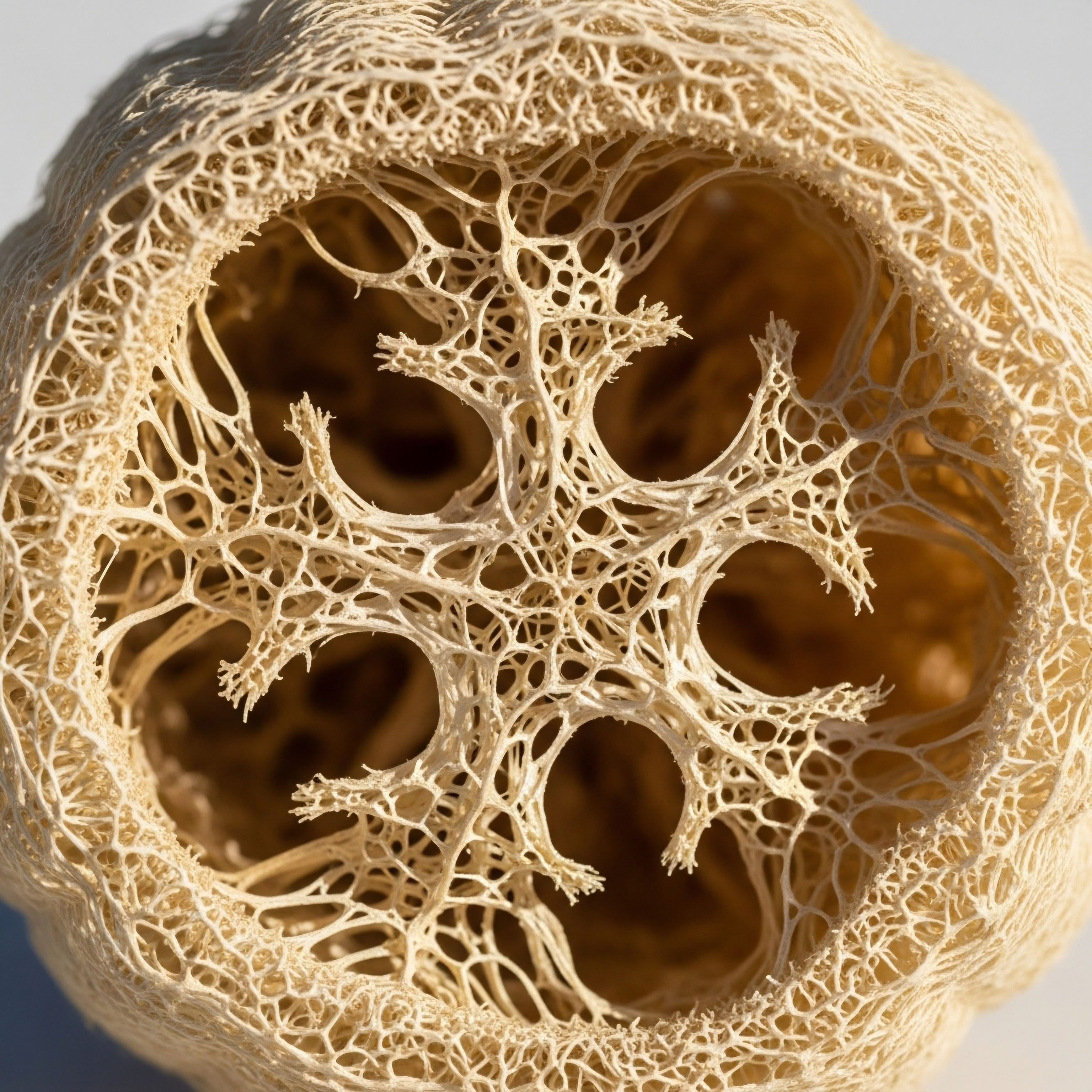

Cellular Directives over Surface Repair
The conversation around skin longevity has long been dominated by a single molecule ∞ retinol. It operates through a well-understood mechanism of accelerating cellular turnover, essentially refinishing the surface layer of the skin. This process addresses texture, pigmentation, and fine lines by forcing the replacement of older cells with new ones. This is an effective, yet fundamentally external, approach. It is a form of managed stress, compelling the epidermis to regenerate faster.
Peptides introduce a completely different operational philosophy. They function as biological messengers, composed of short-chain amino acids, the very building blocks of proteins like collagen and elastin. Their role is not to mechanically resurface, but to deliver precise instructions to the cellular machinery deep within the dermis.
A peptide like GHK-Cu, for example, doesn’t just encourage new collagen; it signals for the simultaneous breakdown of old, disorganized collagen fibers and the synthesis of a new, resilient matrix. This is the critical distinction ∞ it is a shift from surface-level repair to systemic architectural planning. Peptides are the logisticians and project managers of cellular construction, ensuring the right materials are ordered, the old structures are properly demolished, and the new framework is built to superior specifications.

The Limits of Forced Turnover
Retinoids, while clinically proven, function by binding to specific receptors that trigger a state of heightened proliferation. This can lead to the well-documented side effects of irritation, dryness, and photosensitivity, as the skin’s barrier is temporarily compromised during this rapid turnover. It is a powerful tool, but one that operates by inducing a low-grade inflammatory response to spur action. The body is commanded to repair itself, a directive that comes with inherent biological costs.

The Precision of Biological Language
Peptides, conversely, speak the native language of the cell. They mimic the body’s own signaling proteins, tricking cells into initiating specific, targeted functions. Some peptides signal for increased collagen production, others for enhanced hydration, and a select few even modulate inflammatory responses or muscle contractions. This allows for a multi-layered strategy.
One can use a specific peptide to address firmness, another for barrier repair, and a third to calm inflammation. This is not a blunt instrument forcing cell division; it is a nuanced dialogue with your own biology, using its own vocabulary to request specific, desirable outcomes with minimal disruption.


The Mechanics of Peptide Communication
To grasp how peptides orchestrate cellular change is to understand the body as a complex communication network. Every cell is studded with receptors, which function like highly specific docking stations. Peptides are the keys, engineered by nature or in a lab, to fit these locks.
When a peptide binds to its corresponding receptor, it initiates a signaling cascade ∞ a chain reaction of biochemical events inside the cell that culminates in a specific genetic expression. This is the essence of their power ∞ they do not become part of the final structure, but they are the catalyst that gives the order for its creation.
The OS-01 peptide is the first peptide scientifically proven to reduce skin’s biological age.
Consider the process of building collagen, the primary structural protein that gives skin its density and firmness. As we age, the signal to produce robust collagen weakens. A carrier peptide, such as a copper peptide (GHK-Cu), acts as a delivery vehicle for essential minerals like copper, a critical cofactor in collagen synthesis.
Signal peptides, like Matrixyl (Palmitoyl Pentapeptide-4), directly mimic a fragment of broken-down collagen, fooling the fibroblasts into believing there has been an injury. This bio-deception triggers a powerful wound-healing response, ramping up the production of new, high-quality collagen and elastin to “repair” the perceived damage.

A Catalog of Cellular Instructions
The versatility of peptides lies in their specificity. Different amino acid sequences create different “keys,” each unlocking a unique cellular function. This allows for a level of targeted intervention that is simply not possible with a single-mechanism molecule.
-

Signal Peptides
These are the project foremen. They directly stimulate fibroblasts to produce more collagen, elastin, and other proteins that form the dermal matrix. Their function is purely instructional, telling the cell to increase its output of structural components.
-

Carrier Peptides
These are the logistical experts. They stabilize and deliver essential trace elements, like copper and manganese, that are vital for enzymatic processes such as collagen and elastin synthesis. They ensure the cellular factory has the raw materials it needs to follow the foreman’s orders.
-

Neurotransmitter-Inhibiting Peptides
These are the diplomats. Peptides like Argireline function by modulating the release of neurotransmitters at the neuromuscular junction. This leads to a subtle relaxation of facial muscles, reducing the depth and appearance of dynamic wrinkles caused by repeated expressions. They soften the tension that etches lines into the skin.
-

Enzyme-Inhibiting Peptides
These are the preservationists. Certain peptides derived from natural sources like soy or rice can inhibit the action of enzymes, such as matrix metalloproteinases (MMPs), which are responsible for the degradation of collagen. They protect the existing structural integrity of the skin from breakdown.


Protocols for Biological Resonance
Integrating peptides into a personal performance protocol requires a shift in mindset from a nightly corrective ritual to a continuous, strategic dialogue with your skin’s cellular ecosystem. Because peptides are generally well-tolerated and work harmoniously with the skin’s natural processes, they can be used more frequently and with fewer contraindications than retinoids. While most retinoids are restricted to nighttime use due to photosensitivity, peptides can be deployed both morning and night to provide around-the-clock signaling.
The timeline for results is also governed by a different biological clock. Retinoid results are often visible within weeks, tied to the rapid cycle of epidermal turnover. Peptide-driven changes are more foundational and cumulative. The initial effects, such as improved hydration and a plumping of the skin, can be apparent relatively quickly.
However, the true architectural remodeling ∞ the measurable increase in dermal density and firmness from new collagen synthesis ∞ occurs over months. This is the hallmark of true biological change, a patient and persistent reconstruction of the skin’s underlying support structure.

Strategic Deployment and Stacking
A sophisticated approach involves layering or “stacking” different peptide formulations to address multiple pathways simultaneously. A morning protocol might involve a vitamin C serum followed by a carrier peptide like GHK-Cu to support antioxidant defenses and prepare the skin for the day. An evening protocol could then layer a signal peptide to maximize collagen synthesis during the skin’s natural nighttime repair cycle, followed by a nourishing moisturizer to support the skin barrier.
-

The Foundational Phase (months 1-3)
Focus on consistency. The primary objective is to saturate the cellular environment with consistent signals. Use a broad-spectrum multi-peptide serum twice daily to establish a baseline of improved hydration, barrier function, and initial signaling for collagen production.
-

The Targeted Phase (months 4-6)
Introduce specificity. Once the foundation is set, add a targeted peptide to address a primary concern. If dynamic wrinkles are the issue, introduce a neurotransmitter-inhibiting peptide to a specific area. If loss of firmness is the priority, ensure a potent signal peptide is the core of the evening routine.
-

The Optimization Phase (ongoing)
Calibrate and maintain. At this stage, the skin’s matrix is actively being rebuilt. The protocol becomes about maintenance and optimization, potentially cycling different peptide formulations to prevent receptor downregulation and provide a full spectrum of biological support.

Your Biology Is a Conversation
Moving from retinol to peptides is an evolution from shouting orders at your skin to engaging it in an intelligent conversation. It acknowledges that the body is not a passive substrate to be resurfaced, but a dynamic and responsive system that can be guided, signaled, and instructed.
Retinol is a powerful monologue; peptides are a sophisticated dialogue. They offer a future where we no longer merely manage the signs of aging but actively direct the process of cellular regeneration from within. This is the new frontier of vitality ∞ speaking the language of our own biology to write a new code for longevity.



